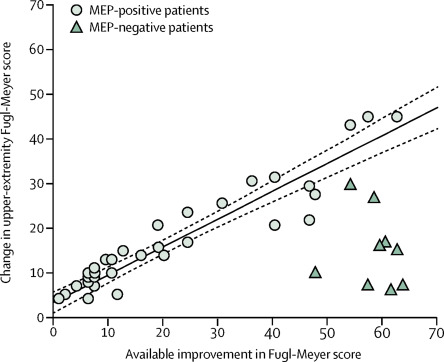Our official English website, www.x-mol.net, welcomes your
feedback! (Note: you will need to create a separate account there.)
Prediction of motor recovery after stroke: advances in biomarkers.
The Lancet ( IF 98.4 ) Pub Date : 2017-10-01 , DOI: 10.1016/s1474-4422(17)30283-1 Cathy M Stinear
The Lancet ( IF 98.4 ) Pub Date : 2017-10-01 , DOI: 10.1016/s1474-4422(17)30283-1 Cathy M Stinear

|
Stroke remains a leading cause of adult disability, and the recovery of motor function after stroke is crucial for the patient to regain independence. However, making accurate predictions of a patient's motor recovery and outcome is difficult when based on clinical assessment alone. Clinical assessment of motor impairment within a few days of stroke can help to predict subsequent recovery, while neurophysiological and neuroimaging biomarkers of corticomotor structure and function can help to predict both motor recovery and motor outcome after stroke. The combination of biomarkers can provide clinically useful information when planning the personalised rehabilitation of a patient. These biomarkers can also be used for patient selection and stratification in trials investigating rehabilitation interventions that are initiated early after stroke. Ongoing multicentre trials that incorporate motor biomarkers could help to bring their use into routine clinical practice.
中文翻译:

中风后运动恢复的预测:生物标志物的发展。
中风仍然是成人残疾的主要原因,中风后运动功能的恢复对于患者恢复独立至关重要。但是,仅基于临床评估时,很难准确预测患者的运动恢复和结果。脑卒中后几天内运动障碍的临床评估可以帮助预测随后的恢复,而皮质运动结构和功能的神经生理学和神经影像生物标志物可以帮助预测脑卒中后的运动恢复和运动结局。当计划患者的个性化康复时,生物标志物的组合可以提供临床上有用的信息。这些生物标记物还可用于研究卒中后早期开始的康复干预措施的试验中的患者选择和分层。
更新日期:2017-09-12
中文翻译:

中风后运动恢复的预测:生物标志物的发展。
中风仍然是成人残疾的主要原因,中风后运动功能的恢复对于患者恢复独立至关重要。但是,仅基于临床评估时,很难准确预测患者的运动恢复和结果。脑卒中后几天内运动障碍的临床评估可以帮助预测随后的恢复,而皮质运动结构和功能的神经生理学和神经影像生物标志物可以帮助预测脑卒中后的运动恢复和运动结局。当计划患者的个性化康复时,生物标志物的组合可以提供临床上有用的信息。这些生物标记物还可用于研究卒中后早期开始的康复干预措施的试验中的患者选择和分层。











































 京公网安备 11010802027423号
京公网安备 11010802027423号